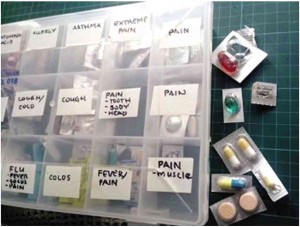
There was a text message on my cellphone asking, “What medicine can I give my daughter for a fever?” It was from my brother in Davao, and he needed some help for his youngest daughter. His wife passed away recently, and family illnesses and remedies had been her charge in their relationship. Now that she was gone, he was suddenly been thrust into the role of the medicine man. Thanks to modern technology, he was given the answer by several relatives and friends via text and Internet in just a few seconds.
Most of us parents do not like to give any medication to our children unless it is necessary. Some doctors prefer to limit it in their professional practice, as well. Serious health conditions should always be referred to a doctor or trained health practitioner. But sooner or later, your child (or spouse, parent or friend) will need relief from a cold or fever. They may develop an allergic reaction or get a rash that needs some kind of medicated cream. There are a multitude of ailments that may need over-the-counter (OTC) treatments or prescription ones.
Your pediatrician prescribes a medicine, but you have to be Dr. Dad (or Dr. Mom) to get it inside your child. As a parent, I hate feeling helpless when it comes to taking care of my kids. It is frustrating when you have to do something, but have no idea what to do. I was fortunate that, as a boy, my parents signed me up for the Boy Scouts, where “be prepared” was the motto, and basic first aid was included in our training.
I have read books and manuals on family health, and I have noted advice from our family doctor so that the not-so-serious illnesses we encounter can be handled at home with less stress.
My uncle, Dr. Eugene Cepeda, is a great source of medical advice. Here are a few things a parent should be aware of when it comes to medications.
Diphenhydramine
This antihistamine comes in liquid, tablet or capsule form. It is used to help make any type of allergic reaction subside. One of the most common afflictions to use this for is hives. These are raised white or red welts or patches on the skin that appear in different sizes. Hives are mostly caused by an allergic reaction. They rarely occur on the face, but often to appear on the chest, abdomen or back and quickly spread to other areas, including the arms and legs. Creams and lotions do not work as well as the oral medication. Read the packaging for dosage and frequency.
Diphenydramine can be given every 6 hours as needed.
Children under 2 years of age—consult a physician
2 to 3 years—12.5 mg
4 to 5 years—8.75 mg
6 to 11 years—25 mg
12 years and above—50mg
Antibiotics
With proper use, they are an important part of the modern health-care system. They save lives and prevent unnecessary pain and suffering. Almost every child may need them some time. One of the challenges for your pediatrician is deciding whether an antibiotic is needed or not. He may prescribe one in case of a bacterial infection (antibiotics work against bacteria, but not against viruses), or a suspected bacterial infection. You should let a doctor determine whether your child has an untreatable virus that may go away on its own, or a serious bacterial infection.
Fever and pain relief
This is probably the biggest reason that parents may need to give their child medication. Pain and fever treatment use the same medicines.
Acetaminophen (also called paracetamol). This can be used for all ages for the relief of pain (from any cause) and for fever. Available in liquid, tablets, chewables and suppositories. Can be given every four hours as needed. Dosage is based on body weight.
Ibuprofen. Like acetaminophen, it is used for everyone, from infants to the elderly, for relieving fever and pain. A main difference is that it is anti-inflammatory, so it may work better for problems like menstrual cramps, muscle and joint pain, swelling from injuries, fevers and irritability due to vaccinations. Dosage is based on body weight and may be given every six hours.
Ziploc bag
A few years ago, in our home, we kept a supply of pills, capsules and tablets of commonly needed medications in a large Ziploc plastic bag. You could see through it and know that you were well stocked. Even older kids somehow look at you as the family medicine expert and ask you (repeatedly) what they should take out of the bag for their ailments (even if they have taken the medication several times before.)
Psychologists say this behavior in children is not laziness to remember, but rather, it reinforces their sense of security that there is someone in control, especially in times of sickness when their bodies are not working right. The medicine bag has a drawback in that family members may mix up the contents each time they need a particular item. Soon, it is hard to tell if we are running low on certain medicines. As a do-it-yourself tool guy, I decided to set up the medicines in an organizer box from the tool shop (also available in craft and sewing shops). I labeled each with its use and dosage. It is so convenient for the whole family.
Stocking your med cabinet
You may keep certain medicines on hand so that you do not have to rush out at inconvenient times. Also, some items are not found in all drugstores. Here is a list of doctor recommended medicines to have at home:
Acetaminophen (paracetamol)
Ibubrofen
Antibiotic ointment (for cuts and abrasions)
Diphenhydramine for allergic reactions
Cough and colds medicine
Vitamin C for immunity boosting
Sinus medicine
Eardrops for earaches
Hydrocortisone cream 1% for itchy rashes
Anti-itch solution for insect bite relief
Medications come and go and dosage recommendations may change. Consult your doctor and check the latest dosage recommendations on the packaging.